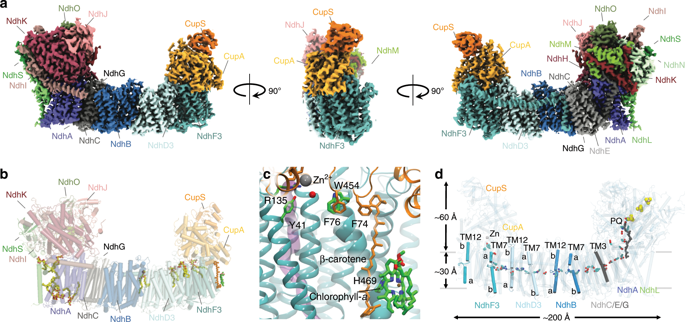当前位置:
X-MOL 学术
›
Nat. Commun.
›
论文详情
Our official English website, www.x-mol.net, welcomes your feedback! (Note: you will need to create a separate account there.)
Redox-coupled proton pumping drives carbon concentration in the photosynthetic complex I.
Nature Communications ( IF 16.6 ) Pub Date : 2020-01-24 , DOI: 10.1038/s41467-020-14347-4 Jan M Schuller 1 , Patricia Saura 2, 3 , Jacqueline Thiemann 4 , Sandra K Schuller 1 , Ana P Gamiz-Hernandez 2, 3 , Genji Kurisu 5, 6 , Marc M Nowaczyk 4 , Ville R I Kaila 2, 3
Nature Communications ( IF 16.6 ) Pub Date : 2020-01-24 , DOI: 10.1038/s41467-020-14347-4 Jan M Schuller 1 , Patricia Saura 2, 3 , Jacqueline Thiemann 4 , Sandra K Schuller 1 , Ana P Gamiz-Hernandez 2, 3 , Genji Kurisu 5, 6 , Marc M Nowaczyk 4 , Ville R I Kaila 2, 3
Affiliation

|
Photosynthetic organisms capture light energy to drive their energy metabolism, and employ the chemical reducing power to convert carbon dioxide (CO2) into organic molecules. Photorespiration, however, significantly reduces the photosynthetic yields. To survive under low CO2 concentrations, cyanobacteria evolved unique carbon-concentration mechanisms that enhance the efficiency of photosynthetic CO2 fixation, for which the molecular principles have remained unknown. We show here how modular adaptations enabled the cyanobacterial photosynthetic complex I to concentrate CO2 using a redox-driven proton-pumping machinery. Our cryo-electron microscopy structure at 3.2 Å resolution shows a catalytic carbonic anhydrase module that harbours a Zn2+ active site, with connectivity to proton-pumping subunits that are activated by electron transfer from photosystem I. Our findings illustrate molecular principles in the photosynthetic complex I machinery that enabled cyanobacteria to survive in drastically changing CO2 conditions.
中文翻译:

氧化还原耦合质子泵驱动光合作用I中的碳浓度。
光合生物捕获光能以驱动其能量代谢,并利用化学还原能力将二氧化碳(CO2)转换为有机分子。然而,光呼吸显着降低了光合产量。为了在低CO2浓度下生存,蓝细菌进化出独特的碳浓缩机制,该机制提高了光合作用CO2固定的效率,其分子原理仍然未知。我们在这里展示了模块化的适应如何使蓝细菌光合复合体I使用氧化还原驱动的质子泵送机械浓缩CO2。我们在3.2Å分辨率下的低温电子显微镜结构显示了带有Zn2 +活性位点的催化碳酸酐酶模块,
更新日期:2020-01-24
中文翻译:

氧化还原耦合质子泵驱动光合作用I中的碳浓度。
光合生物捕获光能以驱动其能量代谢,并利用化学还原能力将二氧化碳(CO2)转换为有机分子。然而,光呼吸显着降低了光合产量。为了在低CO2浓度下生存,蓝细菌进化出独特的碳浓缩机制,该机制提高了光合作用CO2固定的效率,其分子原理仍然未知。我们在这里展示了模块化的适应如何使蓝细菌光合复合体I使用氧化还原驱动的质子泵送机械浓缩CO2。我们在3.2Å分辨率下的低温电子显微镜结构显示了带有Zn2 +活性位点的催化碳酸酐酶模块,


























 京公网安备 11010802027423号
京公网安备 11010802027423号